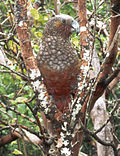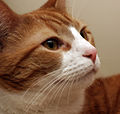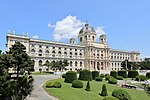The kākāpō (Māori: [kaːkaːpɔː]; pl.: kākāpō; Strigops habroptilus), sometimes known as the owl parrot or owl-faced parrot, is a species of large, nocturnal...
100 KB (11,333 words) - 02:31, 23 November 2024
Sirocco (parrot) (redirect from Sirocco the Kakapo)
other kākāpō, this led to his being imprinted on humans instead of on his mother. As an older bird, he still would not associate with other kākāpō. This...
12 KB (1,113 words) - 19:13, 8 October 2024
Codfish Island / Whenua Hou (section Kākāpō)
breeding population of critically endangered kākāpō it has become the centre for kākāpō recovery. In 2002, 24 kākāpō chicks fledged on the island. In 2009 and...
8 KB (669 words) - 03:38, 22 November 2024
predators, hence parrots evolved to fill habitats from the ground dwelling kākāpō to the alpine dwelling kea as well as a variety of forest species. The arrival...
10 KB (953 words) - 20:01, 24 November 2024
Little Barrier Island (section Kākāpō)
giant wētā. Kākāpō (night parrots), also critically endangered, were first translocated to Little Barrier Island/Hauturu in 1982. Kākāpō successfully...
24 KB (2,358 words) - 20:15, 30 October 2024
by birds, and the lack of mammalian predators led to some like the kiwi, kākāpō, weka and takahē evolving flightlessness. The arrival of humans, associated...
267 KB (22,150 words) - 18:56, 23 November 2024
the island, while the local owls are too small to prey on the kākāpō at night. The kākāpō is the only flightless bird in the world to use a lek-breeding...
32 KB (2,904 words) - 18:50, 8 October 2024
Helena hoopoe, Upupa antaios † Jamaican caracara, Caracara tellustris † Kākāpō, Strigops habroptilus Lyall's wren, Xenicus lyalli † Long-billed wren, Dendroscansor...
38 KB (3,855 words) - 20:22, 18 November 2024
Chalky Island (New Zealand) (section Kākāpō)
last five kākāpō held on Maud island were transferred to Chalky Island. The group was composed of four male kākāpō and one female. Several kākāpō were translocated...
8 KB (761 words) - 02:27, 6 November 2024
Anchor Island (section Kākāpō)
species kākāpō. The first kākāpō were transferred to Pukenui in 2005 after stoat eradication in 2001. These birds are managed by the Kākāpō Recovery...
6 KB (504 words) - 23:16, 9 November 2024
The Kākāpō River is a river of New Zealand. It is located in the West Coast Region of the South Island. The river flows northwest from its source three...
2 KB (72 words) - 22:07, 14 July 2024
Meridian Energy (section Kākāpō Recovery Programme)
National Partners of the Department of Conservation Kākāpō Recovery Programme since 2016. Kākāpō are an endangered New Zealand native parrot. The involvement...
30 KB (2,399 words) - 04:26, 22 November 2024
second-place winner, the little penguin. 2008: The successful campaign to elect kākāpō was accused by the takahē of accepting undeclared donations "from wealthy...
30 KB (2,021 words) - 05:04, 21 November 2024
was deafening. The mix includes species with unusual biology such as the kākāpō which is the world's only flightless, nocturnal parrot which also exhibits...
23 KB (2,349 words) - 18:10, 15 November 2024
closest relatives, the Kea and Kākāpō. The rhinotheca (upper part of the beak) of the Kākā is narrower than the Kākāpo and slightly longer. However, it...
46 KB (5,214 words) - 18:05, 21 November 2024
Pirongia and Pureora. On July 20, 2023, four kākāpō were reintroduced to the sanctuary, becoming the first kākāpō living in mainland New Zealand in almost...
17 KB (1,573 words) - 07:48, 2 November 2024
These were the aye-aye in Madagascar, the Komodo dragon in Indonesia, the kākāpō in New Zealand, the Amazonian manatee in Brazil, the Yangtze river dolphin...
11 KB (1,397 words) - 00:45, 21 August 2024
project are; kākāpō, takahē, tieke, mohua, fiordland skink and rock wren. Kākāpō can be found on Chalky and Anchor Island as a part of the Kākāpō Recovery...
3 KB (295 words) - 06:40, 24 November 2024
Last Chance to See (TV series) (section 5. "Kakapo")
the natural habitat of the kākāpō, a critically endangered flightless parrot now confined to two offshore islands. Kākāpō numbers were decimated by predators...
18 KB (2,105 words) - 23:58, 22 November 2024
Nelson Lakes National Park (section Kākāpō)
extinct in the national park. Kākāpō were common in the national park in the 1800s. Mary Thornton described "the kokapaw (kakapo)" as "good eating … all feathers...
27 KB (2,736 words) - 04:08, 22 November 2024
visual and auditory range of each other. An exploded lek, as seen in the kākāpō (the owl parrot), has more widely separated territories, but still in auditory...
39 KB (4,114 words) - 23:56, 7 September 2024
List of endangered birds (section Kakapo species)
Extinct in the wild (EW): 5 species Critically endangered (CR): 223 species Endangered (EN): 460 species Vulnerable (VU): 798 species Near threatened...
25 KB (1,533 words) - 23:07, 22 November 2024
was deafening. The mix includes species with unusual biology such as the kākāpō which is the world's only flightless, nocturnal, lek-breeding parrot, but...
331 KB (29,256 words) - 16:09, 25 November 2024
discovered the lek breeding system of the kākāpō. When Merton began his work as a conservationist, kākāpō were believed to be extinct, but about 20 years...
18 KB (2,100 words) - 05:35, 22 June 2024
the two extant genera of the parrot family Strigopidae. Together with the kākāpō, and the extinct parrots in the genus Nelepsittacus, they form the parrot...
14 KB (1,060 words) - 20:01, 29 September 2024
"whiskers" are kiwis, flycatchers, swallows, nightjars, whip-poor-wills, the kākāpō and the long-whiskered owlet (Xenoglaux loweryi). Some fish have slender...
41 KB (4,569 words) - 14:19, 21 November 2024
one kākāpō, three kākāpō). Large numbers of native plants and animals retain their Māori names in New Zealand English. Examples include: Birds: kākāpō, kea...
9 KB (812 words) - 21:31, 12 October 2024
Nestor (Kea and Kākā), Strigops (Kākāpō) and the fossil Nelepsittacus. It may have been the ancestor of the kākāpō. The species was likely flightless...
8 KB (923 words) - 02:15, 27 July 2024
Zealand region Subfamily Strigopinae: the flightless, critically endangered kākāpō of New Zealand Superfamily Cacatuoidea: cockatoos Family Cacatuidae Subfamily...
111 KB (11,752 words) - 06:03, 25 November 2024
Kākāpō specimens at the museum...
28 KB (3,313 words) - 09:31, 21 October 2024
























